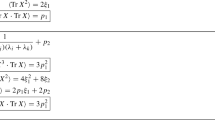Abstract
We consider the simplest gauge theories given by one-and two-matrix integrals and concentrate on their stringy and geometric properties. We recall the general integrable structure behind the matrix integrals and turn to the geometric properties of planar matrix models, demonstrating that they are universally described in terms of integrable systems directly related to the theory of complex curves. We study the main ingredients of this geometric picture, suggesting that it can be generalized beyond one complex dimension, and formulate them in terms of semiclassical integrable systems solved by constructing tau functions or prepotentials. We discuss the complex curves and tau functions of one-and two-matrix models in detail.
Similar content being viewed by others
References
A. M. Polyakov, Gauge Fields and Strings (Contemporary Concepts in Physics, Vol. 3), Harwood, Chur, Switzerland (1987).
J. Polchinski, Phys. Rev. Lett., 75, 4724 (1995); hep-th/9510017 (1995); Progr. Theoret. Phys. (Suppl.), 123, 9 (1996); hep-th/9511157 (1995); Rev. Modern Phys., 68, 1245 (1996); hep-th/9607050 (1996); “TASI lectures on D-branes,” hep-th/9611050 (1996).
J. Polchinski, String Theory, Vols. 1, 2, Cambridge Univ. Press, Cambridge (1998).
J. M. Maldacena, “TASI 2003 lectures on AdS/CFT,” hep-th/0309246 (2003).
A. V. Marshakov, Phys. Usp., 45, 915 (2002); hep-th/0212114 (2002).
G. ’t Hooft, Nucl. Phys. B, 72, 461 (1974).
E. Brézin, C. Itzykson, G. Parisi, and J.-B. Zuber, Comm. Math. Phys., 59, 35 (1978); F. David, Nucl. Phys. B, 257[FS14], 45 (1985); V. Kazakov, Phys. Lett. B, 150, 282 (1985).
E. Witten, Comm. Math. Phys., 252, 189 (2004); hep-th/0312171 (2003); Adv. Theor. Math. Phys., 8, 779 (2004); hep-th/0403199 (2004); D. Polyakov, Phys. Lett. B, 611, 173 (2005); hep-th/0501219 (2005).
A. Gerasimov, A. Marshakov, A. Mironov, A. Morozov, and A. Orlov, Nucl. Phys. B, 357, 565 (1991).
S. Kharchev, A. Marshakov, A. Mironov, A. Orlov, and A. Zabrodin, Nucl. Phys. B, 366, 569 (1991).
T. Miwa, Proc. Japan Acad. A, 58, 9 (1982).
S. Kharchev, A. Marshakov, A. Mironov, and A. Morozov, Nucl. Phys. B, 397, 339 (1993).
S. Kharchev, A. Marshakov, A. Mironov, A. Morozov, and A. Zabrodin, Phys. Lett. B, 275, 311 (1992); hep-th/9111037 (1991); Nucl. Phys. B, 380, 181 (1992); hep-th/9201013 (1992).
M. Kontsevich, Funct. Anal. Appl., 25, 123 (1991); Comm. Math. Phys., 147, 1 (1992).
M. Fukuma, H. Kawai, and R. Nakayama, Internat. J. Mod. Phys. A, 6, 1385 (1991); Comm. Math. Phys., 143, 371 (1992).
S. Kharchev and A. Marshakov, “Topological versus non-topological theories and p-q duality in c≤1 2d gravity models,” in: String Theory, Quantum Gravity, and the Unification of the Fundamental Interactions (Proc. Intl. Workshop on String Theory, Quantum Gravity, and the Unification of Fundamental Interactions, Rome, Italy, 1992, M. Bianchi, F. Fucito, E. Marinari, and A. Sagnotti, eds.), World Scientific, Singapore (1993), p. 331; hep-th/9210072 (1992); Internat. J. Mod. Phys. A, 10, 1219 (1995); hep-th/9303100 (1993).
A. A. Migdal, Phys. Rep., 102, 199 (1983).
F. David, Phys. Lett. B, 302, 403 (1993); hep-th/9212106 (1992).
G. Bonnet, F. David, and B. Eynard, J. Phys. A, 33, 6739 (2000); cond-mat/0003324 (2000).
R. Dijkgraaf and C. Vafa, Nucl. Phys. B, 644, 3 (2002); hep-th/0206255 (2002); Nucl. Phys. B, 644, 21 (2002); hep-th/0207106 (2002); “A perturbative window into non-perturbative physics,” hep-th/0208048 (2002).
G. Felder and R. Riser, Nucl. Phys. B, 691, 251 (2004); hep-th/0401191 (2004).
I. Krichever, Comm. Pure. Appl. Math., 47, 437 (1992); hep-th/9205110 (1992).
J. Fay, Theta-Functions on Riemann Surfaces (Lect. Notes Math., Vol. 352), Springer, Berlin (1973).
B. de Wit and A. V. Marshakov, Theor. Math. Phys., 129, 1504 (2001); hep-th/0105289 (2001).
L. Chekhov and A. Mironov, Phys. Lett. B, 552, 293 (2003); hep-th/0209085 (2002).
L. Chekhov, A. Marshakov, A. Mironov, and D. Vasiliev, Phys. Lett. B, 562, 323 (2003); hep-th/0301071 (2003).
V. A. Kazakov, A. Marshakov, J. A. Minahan, and K. Zarembo, JHEP, 0405, 024 (2004); hep-th/0402207 (2004); A. V. Marshakov, Theor. Math. Phys., 142, 222 (2005); hep-th/0406056 (2004).
M. Mineev-Weinstein, P. B. Wiegmann, and A. Zabrodin, Phys. Rev. Lett., 84, 5106 (2000); nlin.SI/0001007 (2000); I. K. Kostov, I. Krichever, M. Mineev-Weinstein, P. B. Wiegmann, and A. Zabrodin, “ τ-Function for analytic curves,” in: Random Matrices and Their Applications (Math. Sci. Res. Inst. Publ., Vol. 40, P. Bleher and A. Its, eds.), Cambridge Univ. Press, Cambridge (2001), p. 285; hep-th/0005259 (2000); A. Zabrodin, “Matrix models and growth processes: From viscous flows to the quantum Hall effect,” hep-th/0412219 (2004).
V. A. Kazakov and A. Marshakov, J. Phys. A, 36, 3107 (2003); hep-th/0211236 (2002).
B. Eynard, JHEP, 0301, 051 (2003); hep-th/0210047 (2002).
I. Krichever, A. Marshakov, and A. Zabrodin, Comm. Math. Phys., 259, 1 (2005); hep-th/0309010 (2003).
A. V. Marshakov, “Matrix models, complex geometry, and integrable systems: II,” Theor. Math. Phys. (to appear); hep-th/0601214 (2006).
A. Marshakov, P. Wiegmann, and A. Zabrodin, Comm. Math. Phys., 227, 131 (2002); hep-th/0109048 (2001).
L. A. Takhtajan, Lett. Math. Phys., 56, 181 (2001); math.QA/0102164 (2001).
Author information
Authors and Affiliations
Additional information
[This article was written at the request of the Editorial Board. It is based on several lectures presented at schools of mathematical physics and talks at the conference “Complex Geometry and String Theory” and the Polivanov memorial seminar.]
__________
Translated from Teoreticheskaya i Matematicheskaya Fizika, Vol. 147, No. 2, pp. 163–228, May, 2006.
Rights and permissions
About this article
Cite this article
Marshakov, A.V. Matrix models, complex geometry, and integrable systems: I. Theor Math Phys 147, 583–636 (2006). https://doi.org/10.1007/s11232-006-0065-x
Received:
Issue Date:
DOI: https://doi.org/10.1007/s11232-006-0065-x



